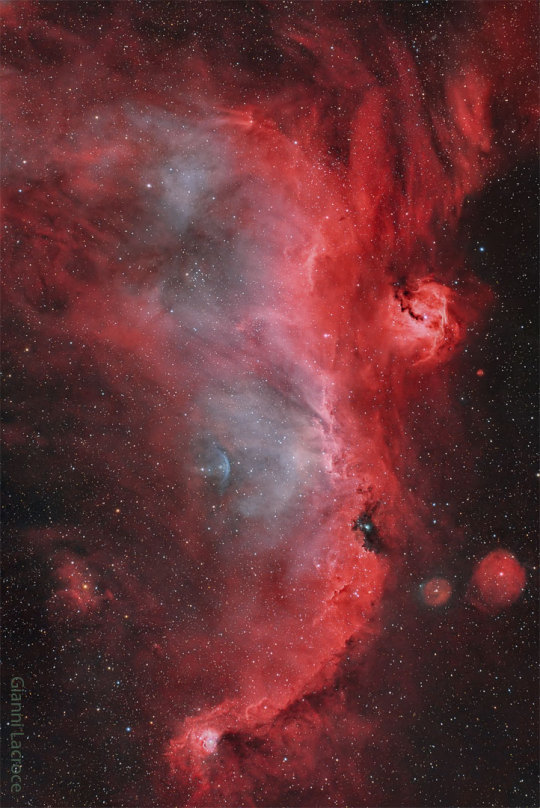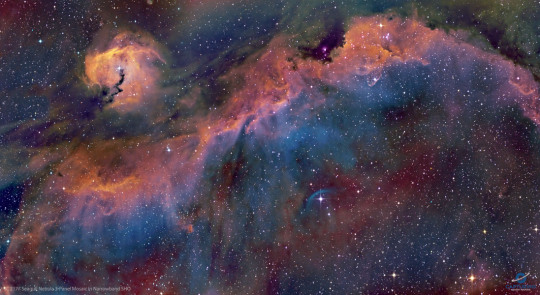#fn canis majoris
Explore tagged Tumblr posts
Text
[source]

The Seagull Nebula © Gianni Lacroce
#reblog#apod#astrophotography#ic 2177#sharpless 2-296#seagull nebula#emission nebula#fn canis majoris#runaway star#canis major#gianni lacroce
3K notes
·
View notes
Photo

2023 January 19
The Seagull Nebula Image Credit & Copyright: Carlos Taylor
Explanation: A broad expanse of glowing gas and dust presents a bird-like visage to astronomers from planet Earth, suggesting its popular moniker - The Seagull Nebula. Using narrowband image data, this 3-panel mosaic of the cosmic bird covers a 2.5 degree swath across the plane of the Milky Way, near the direction of Sirius, alpha star of the constellation Canis Major. Likely part of a larger shell structure swept up by successive supernova explosions, the broad Seagull Nebula is cataloged as Sh2-296 and IC 2177. The prominent bluish arc below and right of center is a bow shock from runaway star FN Canis Majoris. This complex of gas and dust clouds with other stars of the Canis Majoris OB1 association spans over 200 light-years at the Seagull Nebula's estimated 3,800 light-year distance.
∞ Source: apod.nasa.gov/apod/ap230119.html
169 notes
·
View notes
Text

A broad expanse of glowing gas and dust presents a bird-like visage to astronomers from planet Earth, suggesting its popular moniker - The Seagull Nebula. Using narrowband image data, this 3-panel mosaic of the cosmic bird covers a 2.5 degree swath across the plane of the Milky Way, near the direction of Sirius, alpha star of the constellation Canis Major. Likely part of a larger shell structure swept up by successive supernova explosions, the broad Seagull Nebula is cataloged as Sh2-296 and IC 2177. The prominent bluish arc below and right of center is a bow shock from runaway star FN Canis Majoris. This complex of gas and dust clouds with other stars of the Canis Majoris OB1 association spans over 200 light-years at the Seagull Nebula's estimated 3,800 light-year distance.
21 notes
·
View notes
Photo

The Seagull Nebula - Carlos Taylor A broad expanse of glowing gas and dust presents a bird-like visage to astronomers from planet Earth, suggesting its popular moniker - The Seagull Nebula. Using narrowband image data, this 3-panel mosaic of the cosmic bird covers a 2.5 degree swath across the plane of the Milky Way, near the direction of Sirius, alpha star of the constellation Canis Major. Likely part of a larger shell structure swept up by successive supernova explosions, the broad Seagull Nebula is cataloged as Sh2-296 and IC 2177. The prominent bluish arc below and right of center is a bow shock from runaway star FN Canis Majoris. This complex of gas and dust clouds with other stars of the Canis Majoris OB1 association spans over 200 light-years at the Seagull Nebula's estimated 3,800 light-year distance.
4 notes
·
View notes
Text

APOD: The Seagull Nebula (1/19/23) A broad expanse of glowing gas and dust presents a bird-like visage to astronomers from planet Earth, suggesting its popular moniker - The Seagull Nebula. Using narrowband image data, this 3-panel mosaic of the cosmic bird covers a 2.5 degree swath across the plane of the Milky Way, near the direction of Sirius, alpha star of the constellation Canis Major. Likely part of a larger shell structure swept up by successive supernova explosions, the broad Seagull Nebula is cataloged as Sh2-296 and IC 2177. The prominent bluish arc below and right of center is a bow shock from runaway star FN Canis Majoris. This complex of gas and dust clouds with other stars of the Canis Majoris OB1 association spans over 200 light-years at the Seagull Nebula's estimated 3,800 light-year distance. © Carlos Taylor
2 notes
·
View notes
Photo

The Seagull Nebula via NASA https://ift.tt/QY1NT4l
A broad expanse of glowing gas and dust presents a bird-like visage to astronomers from planet Earth, suggesting its popular moniker - The Seagull Nebula. Using narrowband image data, this 3-panel mosaic of the cosmic bird covers a 2.5 degree swath across the plane of the Milky Way, near the direction of Sirius, alpha star of the constellation Canis Major. Likely part of a larger shell structure swept up by successive supernova explosions, the broad Seagull Nebula is cataloged as Sh2-296 and IC 2177. The prominent bluish arc below and right of center is a bow shock from runaway star FN Canis Majoris. This complex of gas and dust clouds with other stars of the Canis Majoris OB1 association spans over 200 light-years at the Seagull Nebula's estimated 3,800 light-year distance.
0 notes
Text

APOD: The Seagull Nebula (1/19/23) A broad expanse of glowing gas and dust presents a bird-like visage to astronomers from planet Earth, suggesting its popular moniker - The Seagull Nebula. Using narrowband image data, this 3-panel mosaic of the cosmic bird covers a 2.5 degree swath across the plane of the Milky Way, near the direction of Sirius, alpha star of the constellation Canis Major. Likely part of a larger shell structure swept up by successive supernova explosions, the broad Seagull Nebula is cataloged as Sh2-296 and IC 2177. The prominent bluish arc below and right of center is a bow shock from runaway star FN Canis Majoris. This complex of gas and dust clouds with other stars of the Canis Majoris OB1 association spans over 200 light-years at the Seagull Nebula's estimated 3,800 light-year distance. © Carlos Taylor
1 note
·
View note